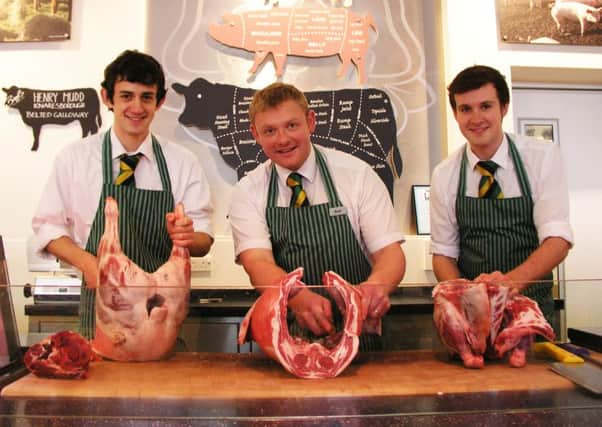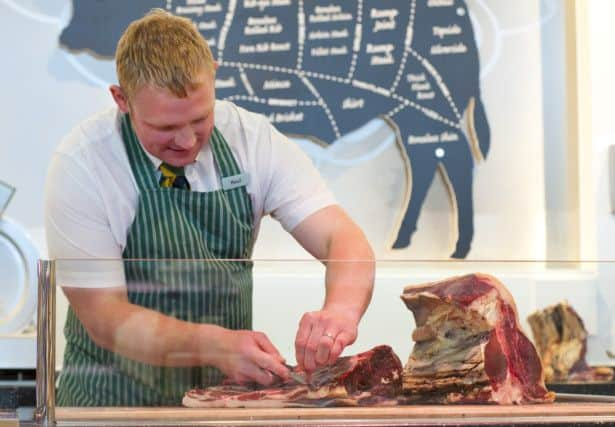New kids on the block


THERE’S a whole side of beef hanging up behind the butchers’ counter at Fodder, in Harrogate, and it’s in full view of the customers through a large window.
If any of them ask what breed it is, or which Yorkshire farm it’s from, all the butchers serving know, just as they’ll answer any questions about which part of the animal the customer’s chosen cut is from.
Advertisement
Hide AdAdvertisement
Hide AdAnd they do get asked, partly because it’s unusual these days to see whole carcasses in butcher’s shops and partly because the window just over their shoulders allows the public an insight into the journey that their evening meal has taken from farm to plate.


There’s another, equally important, reason that the shop buys in whole animals, and that’s to help keep traditional butchery skills alive as part of the Yorkshire Agricultural Society’s work in supporting the rural economy.
Times are not easy for butchers. The days when every high street had its family-run shop with staff in striped aprons are receding into the past as many shut in the face of supermarket dominance of how we buy food.
Figures from HM Revenue and Customs reveal that nationally the number of shops is dwindling. In 2000, there were more than 9,000. Now, it’s down to just over 7,000. That equates to 23 shutting every month, and with every closure, skills are being lost. The trade is not attracting as many young people as it should, and even amongst the many excellent butcher’s shops in Yorkshire that thrive and have loyal customers, apprentices are relatively rare.
Advertisement
Hide AdAdvertisement
Hide AdThat makes Fodder, at the Great Yorkshire Showground, very unusual because it has two, one recently qualified and the second not far off completing his apprenticeship. He’s Callum Milne, 22, who today is working on hindquarters of beef on the heavy wooden block, his use of a couple of scalpel-sharp knives assured and skilful under the approving eye of head butcher Paul Nicholson.
Paul said: “When I was learning my trade, once you’d got to the hindquarters you’d learned everything, so he’s getting well on. It’s a dying trade is butchery, and people don’t realise. People don’t see it as an attractive job. They think if you’re going into joinery, plumbing, engineering, it’s going to be a better life than a butcher’s.”
But for Callum, from Knaresborough, a butcher’s life is just fine, after he left school with no clear idea of what he wanted to do, and began work in Fodder’s cafe. Paul’s skills caught his eye.
Callum said: “I wanted to work and make some money, not go to university, and this came along out of the blue after Paul asked me if I was interested.
Advertisement
Hide AdAdvertisement
Hide Ad“I never planned to be an apprentice, never thought I’d take to it, but did a couple of months here and they offered me the apprenticeship and I love it, I really enjoy it.”
Paul, 39, added: “We were looking for somebody and he looked a bit bored just making coffees. I thought: ‘What a waste of a young lad up there’, and we ought to get him into a trade. We need more youngsters in butchery.”
Callum’s apprenticeship lasts 18 months and involves a day a week on a butchery course at Leeds City College, where he is one of only about 20 trainees from across the region. The rest of his training is done on the job.
Sam Hurren, 21, was Fodder’s first apprentice butcher after starting at the shop as a Saturday boy when he was 17. He went through the same training as Callum and is now fully qualified.
Advertisement
Hide AdAdvertisement
Hide AdBoth came into the trade at a time when, for all the pressure on traditional family butchers, they received an unexpected boost to their fortunes, as did Fodder. It was in March 2013 that the “Horsegate” scandal broke, when it emerged that products being sold as beef were in reality contaminated with horsemeat.
The public was horrified and the reputations of several major supermarkets damaged as both found themselves victims of fraud. Complicated international supply chains hid exactly where meat originated – or was being tainted with horse – before ending up in processed products like burgers, pies and lasagne.
Traceability became a primary concern for many consumers and that was good for butchers who could tell them where their meat came from. At Fodder, where all the meat comes from Yorkshire farms, sales shot up by 47 per cent, and the majority of those new customers have stuck with food they can trust.
In January, sales remained 34 per cent up on what they had been before the scandal, good news for a shop where all profits go to fund the work of the Yorkshire Agricultural Society, the charity at the heart of the county’s rural life.
Advertisement
Hide AdAdvertisement
Hide AdCallum said: “There’s a big focus at college on transparency and traceability, and that’s the edge that butcher’s shops have over supermarkets. I didn’t know anything at all when I first started, and had problems identifying things for the first couple of months. Like a lot of people, I just bought stuff off the shelf and didn’t really know where it came from.”
He was far from alone in that. The decline of the traditional butcher, with shops closing has gone hand-in-hand with a growing disconnect between substantial sections of society – especially those in urban areas – and the countryside. Survey after survey has shown a glaring lack of knowledge, particularly amongst the young, about where the pre-packed food on the supermarket shelves comes from.
Paul recognises this and believes butchers have their part to play in changing it. He’s a farmer’s son who has been around livestock all his life and buys Fodder’s meat, going out to farms across Yorkshire to select animals.
“People don’t see the full chain through from farm to plate. The customers that talk to us are interested in the meat, we like to educate people.”
Advertisement
Hide AdAdvertisement
Hide AdPaul is going into his 24th year as a butcher, and knows that the trade has changed dramatically, which is why he’s so keen on getting younger people involved.
“I’ve learned it right from the start, from buying it, slaughtering it, cutting it up and even selling it on a van. We see it as a challenge to get it in as full carcasses, plus if we didn’t, Callum and Sam wouldn’t learn to be proper butchers.
“College is very good for them. There weren’t apprenticeships as butchers when I started. The lads going to college helps me as well, because they’re seeing different things and bringing ideas back, then in here we can get to the finer points, the presentation, the final touches. We’ve got to keep this trade alive.
“Things have changed so much since I was Callum’s age because nobody asked you how to cook anything, because all the older ladies knew. I’m afraid people nowadays don’t know how to cook, so we give them advice on cooking.”
Advertisement
Hide AdAdvertisement
Hide AdBoth Callum and Sam, despite being much younger than many of their customers, are already handing out that advice.
For Callum, training to be a butcher doesn’t end when he leaves work. It carries on in his kitchen. He said: “It’s one of the hardest things at the start, the first couple of months, advising people how to cook things, but you get into the swing of things.
“What I’m doing is always taking something different home and trying the best way to cook it, because you can’t tell the customer how to do it unless you know yourself.”
• Fodder can be found at www.fodderweb.co.uk